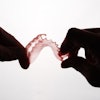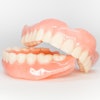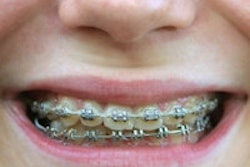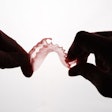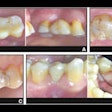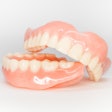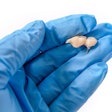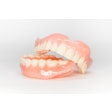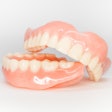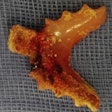
DrBicuspid.com is pleased to present the next column from two lawyers who spend every day defending dentists in litigation and before the licensing board. The purpose of this column is to offer our readers a fresh perspective on common practice and risk management issues from attorneys who litigate these issues in the real world.
A female patient between the ages of 30 and 40 presented to an orthodontist seeking advice on how to close spacing between her upper central incisors and between the lateral incisors and premolars. All complaints were about aesthetics, not function. Tooth No. 7 was missing.
On radiographs, the teeth were in good repair with no decay and a healthy periodontium, consistent with the patient's age. The lateral cephalometric x-ray showed a mild skeletal class II, but this was determined to be essentially a dental, rather than a skeletal, case.

The treatment plan was the placement of upper and lower modern orthodontic technology appliances to level and align the teeth, with the specific goal of closing interdental spaces, which was expected to take 12 to 18 months. The dentist is very experienced with the use of both modern and traditional orthodontic approaches.
Before starting care, the plaintiff signed two consent forms: one for general orthodontics and the other for specifically for the product. These forms set out the risks, expectations, and alternatives. The orthodontist also had detailed discussions with the patient to ensure that she fully understood the issues involved and the differences between the newer orthodontic technology and a banded case.
After the orthodontic treatment was underway, our client suggested that the patient see a general dentist for the purpose of monitoring hygiene and potential decay. The patient complied.
Months into the treatment plan, the general dentist convinced the patient she should open space for two implants. So, our client changed the orthodontic approach to a full-banded case, which was projected to go on for two years from that time.
“The orthodontist also had detailed discussions with the patient to ensure that she fully understood the issues involved.”
Unknown to our client, the patient became unhappy with that general dentist, so she saw no dentist for cleanings and x-ray examinations; our client did not monitor with radiographs.
About a year into the traditional orthodontic treatment, the patient saw a new dentist, who took x-rays and performed an examination, finding severe gingivitis and 50% or more root resorption on all upper incisors. The new dentist determined that all four of those teeth would be lost and a restorative treatment plan for the upper arch was established.
The patient never returned to our client, but instead focused her care with the new general dentist who extracted the four teeth (Nos. 8, 9, 10, and 11).
Legal stance
The plaintiff filed suit, convinced by her new general dentist that the orthodontist was negligent in causing or allowing root resorption to progress, thus leading to the loss of four upper anterior teeth.
Issues raised
Informed consent: The patient claimed that, when the orthodontic treatment changed from the recent technology to traditional, she was not provided with the risks associated with it. However, before the start of this treatment, she signed consent forms for both techniques. The patient claimed that years had passed since she signed those forms, so she was not aware of the risks of traditional orthodontics by the time that phase of the treatment began.
Patient monitoring: It is undisputed that it was our client who initially advised the patient to see a general dentist while orthodontics was ongoing, for the purpose of monitoring the clinical and radiographic conditions of the teeth and supporting structures.
But it is equally undisputed that, our client, once he became aware that the patient began to treat with a general dentist for this purpose, did nothing further in that regard, presuming that someone else was taking care of this. But when the patient left that general dentist's care and did not tell the orthodontist, no monitoring occurred.
The plaintiff's attorney argued that, despite an orthodontic patient being simultaneously under a general dentist's care, the orthodontist has an independent duty to monitor the teeth and supporting structures, both as a backup and to ensure monitoring under circumstances as happened in this case.
Orthodontic technique:: Based on the clinical notes, photographs, and radiographs, there seems to be nothing improper about the actual application and adjustment of the modern appliances or, later on, the braces. Our client and orthodontic expert told us that it is well within the standards of good care to make a change between these two modalities of treatment.
The plaintiff's attorney claimed that forces were excessive and inappropriately directed, thereby leading to the problems of the upper incisor teeth. But this issue was not quantifiable, and the materials used were typical for this type of treatment, so a jury can do nothing else but listen to opposing experts with opposing views and make a determination based on relative credibilities.
Practice tips
Informed consent: Despite having a solid informed-consent process at the start, any significant change in treatment plan warrants revisiting the process. It also should be documented that it was done, preferably by the patient signing a relevant document, but at least a note by the dentist about the discussion.
Our client testified at deposition that there was a complete discussion at the time of the change, but nothing in the chart documents such a discussion. This set of facts also raises the question of how long a signed consent is valid. This is up to the jury, but, from our perspective, the more recent the better.
Patient monitoring It is not unusual for patients to simultaneously treat with several dentists of different practice areas. Consider what obligation each has to do basic monitoring or at least to effectively communicate with the patient and the co-treating dentist to ensure that the patient's stability is under a watchful eye, with a chart entry to document.
This case raises the question of how often radiographs are called for on an orthodontic patient. Opinions vary widely.
Orthodontic technique: Proper chart entries should include enough in the way of detail so that another professional with expertise in the same area will easily be able to determine exactly what was going on at any particular time. Among what is helpful are instruments, technique, and armamentarium used; reasons for changes in treatment plans; refusals and noncompliance by patients; and any untoward events or patient responses. Do not simply ignore when things go wrong.
Root resorption: It would take a standalone article to do justice to this topic. The precise causes of root resorption, according to the literature over the past decade, remain a mystery. Two patients can have identical treatment, yet one may develop significant resorption, while the other has none. Why? Some studies suggest genetic factors are at play. Others suggest that greater forces do not necessarily equal greater resorption.
Conflicting opinions exist about the prognosis of teeth with, for example, 50% resorption. Some studies indicate that these teeth may last a lifetime, but attorneys for patients assume such teeth are hopeless. Is root resorption alone evidence that the dentist was negligent?
What do you think?
In this article, rather than tell you the outcome, we have raised various issues to which there will surely be differing answers among you. The goal is not always to find one answer, because there are usually several, but to get you thinking so that you might implement practice strategies to protect you and your patients. Let us know what you think happened in our Forum dedicated to this series.
Next case: Failure to diagnose and treat periodontal disease
William S. Spiegel, Esq., is a partner at the law firm Spiegel Leffler in New York City. He is a former assistant corporation counsel to the City of New York -- Medical Malpractice Division.
Marc R. Leffler, DDS, Esq., is also a partner at Spiegel Leffler. He received his dental degree from Columbia University, completed a residency in oral and maxillofacial surgery at New York University, and is a diplomate of the American Board of Oral and Maxillofacial Surgery.
Disclaimer: Nothing contained in this column is intended as legal advice. Our practice is focused in the state of New York, and there are variations in rules of practice, evidence, and procedure among the states. This column scratches the surface on many legal issues that could call for a chapter unto themselves.
The comments and observations expressed herein do not necessarily reflect the opinions of DrBicuspid.com, nor should they be construed as an endorsement or admonishment of any particular idea, vendor, or organization.
